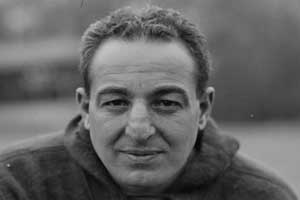Lou Little (1924-1929)
(Portions excerpted from a previous feature at this site.)
In three decades of coaching, Hall of Famer Lou Little coached at only two schools. But there was always more to Little than just a coach.
For one thing, he wasn't really the patrician known as "Louis Lawrence Little", but Luigi Piccirilli, an Italian immigrant who grew up in Boston. After high school a post-graduate stop at Worcester Academy, and a year at Vermont, Piccolo arrived at Pennsylvania in 1916. After his second season at Penn, the 25 year old earned All-America honors at tackle.
Having co-opted an old schoolyard nickname, "Little Luigi", the man now known as Lou Little rose to the rank of captain and seeing action in the Argonne offensive. He returned to Penn and played a final year of college before moving into the newly created National Football League, where he played for two seasons. But there was no money in professional football, so Little took another career turn: coaching.
How Little got to Georgetown is unclear. It's likely he came into contact with Al Exendine, the successful Georgetown coach to whom football was a seasonal pursuit--an attorney by trade, Exendine commuted between Washington and Tulsa in the off-season, and made more money in law than he ever did in coaching at Georgetown.
Little's arrival at Georgetown turned an important page in Georgetown athletics. In the previous forty or so years of organized athletic competition, management of the teams was a student-run enterprise, with coaches hired on a part time basis. The student managers would set the schedules, manage the finances and report to the Jesuit moderators as to the success or failure of their efforts. Little's arrival would be different, as he was not only named head coach but athletic director across all seven Georgetown sports teams.
Little's contributions to Georgetown football were significant on and off the field. He accelerated the recruitment of athletes begun in the Exendine years, reaching out to large midwest cities such as Chicago and Detroit to bring in talent not in the range of the larger Eastern schools. More games were moved off-campus to Griffith Stadium to boost revenues, and the team began to build upon the national reputation garnered under Exendine. Following a 4-4 season in 1924, Georgetown would win 32 of its next 38 over the next four seasons, with a mix of talent and innovation that was the envy of Eastern football. Little lobbied repeatedly, albeit unsuccessfully, to schedule a series with Notre Dame which would further elevate Georgetown as a major program. Knute Rockne admitted as much that Notre Dame wasn't interested in promoting rivalries that would elevate other Catholic schools nationally.
With success came pressure and scrutiny. Following the 1926 season, Georgetown sensed that Little was in demand from some of the larger colleges. An arrangement was made whereby Little would receive 10 percent of the home attendance revenue in addition to his salary. It was a timely move, as the 1927 team would to 8-1 with an undefeated 6-0 record at Griffith Stadium.
In the end, it wasn't Little's reputation that soured, but the issue of money. Following the 1928 season, Little claimed that the Jesuits were undercounting the gate at Griffith Stadium and thus short-changing his 10% share of the revenues. By the time of his contract renewal after the 1929 season, it was an issue that had not been resolved. Sensing an opening, Penn offered $15,000 a year, or nearly double Little's $7,500 base at Georgetown. Columbia, which had seen Little's Georgetown teams gain attention in New York in wins over NYU and Fordham, upped the offer to $18,000 a year. Rev. Coleman Nevils S.J. the new Georgetown president who had inherited the 10 percent bonus plan offered from his predecessor, opted not to pursue him further.
Little arrived in New York as a conquering hero, and left 26 years later in the same way. His 1935 upset of Stanford in the Rose Bowl secured his berth as the greatest coach in Columbia football history, and even as Columbia's football fortunes waned in the 1950's, Little remained a coaching legend.
The timelines of football at Georgetown and Columbia each pass through the tutelage of Lou Little, who died in 1979 at the age of 85. His was an era when each school was at the top of its game.
| Year | Record | Pct. | Home | Away |
| 1924 | 4-4 | 0.500 | 2-2 | 2-2 |
| 1925 | 9-1 | 0.900 | 7-1 | 1-0 |
| 1926 | 7-2-1 | 0.750 | 4-1 | 3-1-1 |
| 1927 | 8-1 | 0.888 | 6-0 | 2-1 |
| 1928 | 8-2 | 0.800 | 6-1 | 2-2 |
| 1929 | 5-2-2 | 0.667 | 3-1-1 | 2-1-1 |
| Totals | 41-12-3 | 0.759 | 28-7-1 | 13-5-2 |
